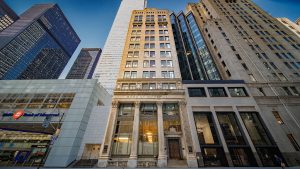The key to coverage lies not in the general nature of the policy itself but in whether the alleged acts fall within its provisions and coverage is not excluded.
CGL insurers must defend owner’s claims of negligence against contractor
Westridge Construction Ltd. v. Zurich Insurance Co. and Sovereign General Insurance Co.
Insurance • Commercial General Liability (“CGL”) Policy • Duty to defend • Negligent misrepresentation claim is not derivative of breach of contract claim • Arises from separate facts • Insurers who denied coverage had duty to defend
In 1994, Westridge Construction built a prefabricated metal swine barn for Genex Swine Group. The project was substantially completed on October 5, 1994. On October 3, 2001, Genex started a lawsuit against Westridge for damages arising from the premature corrosion of the barn’s steel roof.
After Westridge received the claim, it notified the five insurers that had insured it between 1994 and 2001. Three agreed to defend the action and contribute to Westridge’s defence. The other two, Zurich and Sovereign, refused coverage.
Westridge sued for a declaration that Zurich and Sovereign had a duty to defend it in the Genex action.
Genex’s Claim
Genex’s original specifications for its Tullymet Nucleus Unit called for a colour printed sheet steel cladded roof. Westridge gave Genex a list of cost saving alternatives that included replacing the specified roof with a galvalume steel cladding roof. Genex agreed to change the roof.
Genex subsequently discovered that the roof was rusting. By May 2001, the roof was corroded to the point that it constituted a danger to persons and property.
Genex sued Westridge for breach of contract, for constructing a defective roof. Genex also claimed Westridge was negligent in recommending the galvalume roof alternative, when that type of roof was unsuitable for use in a swine barn.
This is another case where an insured — Westridge — claims that its CGL insurance covers a claim made against it, but the insurer denies coverage on the basis that claim is based on the contractor’s defective work, which is not covered.
Insurer’s Duty to Defend
An insurer’s duty to defend its insured is contractual: the insurer determines the scope of its duty in the insurance policy. In this case, Sovereign’s policy stated:
…the Insurer also agrees … to defend … on behalf of the Insured, claims … which may at any time be instituted against the Insured for any occurrence to which this insurance applies, although such claims, suits, proceedings or allegations and demands may be groundless, false or fraudulent…. [Emphasis added.] As the Supreme Court of Canada said in Monenco Ltd. v. Commonwealth Insurance Company:
if the claim alleges … facts which, if proven, would fall within the coverage of the policy the insurer is obliged to defend the suit regardless of the truth or falsity of such allegations. [Emphasis added.]
Because the duty to defend is based upon appearance [what the claim alleges] not reality [what claim is proven], a plaintiff might make false allegations specifically to trigger the insurer’s duty to defend, so that the insurer participates in the lawsuit, and is a deep-pocket to be picked for settlement purposes.
To prevent that mischief, the Supreme Court of Canada in Non-Marine Underwriters, Lloyd’s of London v. Scalera, subjects the claims against an insured to a three-step analysis:
…First, a court should determine which of the plaintiff's legal allegations are properly pleaded…. [The] court must look beyond the choice of labels, and examine the substance of the allegations contained in the pleadings. This does not involve deciding whether the claims have any merit; all a court must do is decide, based on the pleadings, the true nature of the claims.
Finally, …the court must decide whether any of the properly pleaded, non-derivative claims could potentially trigger the insurer’s duty to defend.
In Scalera the insured was sued for a sexual assault alleged to be either an intentional tort or negligence. The Supreme Court of Canada concluded that the negligence claim was completely derivative of the intentional sexual assault (which was not covered by the policy) because both claims relied on the same facts. The Supreme Court had little difficulty reaching this conclusion because an intentional sexual assault and a negligent sexual assault (whatever that is) must logically be mutually exclusive: the only difference is in the state of mind of the insured.
The key issue in this case is how the Scalera analysis applies where the two claims against the insured are not mutually exclusive. Is Genex’s claim for negligent misrepresentation a properly pleaded claim that is not merely derivative of the breach of contract claim? The Saskatchewan Court of Appeal concluded that it is.
The True Nature of Genex’s Claim
Genex properly pleaded a negligence claim against Westridge. At law, Genex was clearly entitled to sue for both breach of contract and negligence, following the Supreme Court of Canada’s decision in BG Checo International Limited v. British Columbia Hydro and Power Authority, where the terms of that contract did not specifically exclude Hydro’s liability for negligent misrepresentation.
Here the contract between Genex and Westridge implicitly permitted claims in negligence. It said that the duties and obligations imposed on Westridge by the contract and the rights and remedies available under it were in addition to and not a limitation of any duties, obligations, rights and remedies otherwise imposed or available by law. [As in General Condition GC 1.3.1 of the CCDC2-1994, for example.] Since the duties in tort, including the duty not to be negligent are imposed or available by law apart from the contract, Genex was entitled to sue Westridge for negligence.
In fact, Genex properly pleaded material facts to support a negligence claim against Westridge. Westridge didn’t just build the roof required by the contract: it specifically recommended a substitute type of roof that was allegedly unsuitable. Westridge’s recommendation makes Genex’s negligence claim legitimate, perhaps even critical, to the Court of Appeal’s finding that the “true nature of the claim” included a true claim for negligent misrepresentation.
Is the Negligence Claim Derivative?
The Court of Appeal saw the negligent misrepresentation claim as non-derivative because the facts to support it are different than [in addition to] those that support the breach of contract claim. The only overlap in the two sets of allegations is in the harm done. Genex gets an unsuitable roof because Westridge recommended it, and built it, after Genex went along with its recommendation.
The Court of Appeal’s conclusion supported the Dionne Farms Ltd. v. Fermes Gervais Ltée case. There a purchaser of seed potatoes claimed the seller negligently misrepresented their quality, when they in fact were infected with bacteria. The New Brunswick Court of Appeal concluded that the claim for negligent misrepresentation was a separate claim not derivative of an action in contract:
…Assuming that an action for damages for breach of contract is not a liability claim envisaged by the coverage provided by this liability policy, the claim framed in negligent misrepresentation is clearly separable from a claim grounded on contract and thus constitutes a non-derivative claim[:]… ‘the allegations of negligence constitutes a separate tort which is supported by entirely different facts.’
Is the Claim Possibly Covered by the Policies
The Court of Appeal also concluded that Genex’s negligent misrepresentation claims could trigger the insurers’ duty to defend, and that their duty to defend was not excluded by the exclusion clauses in the policies.
The trial judge, who concluded otherwise, erred, because he applied the general principle that a CGL policy is not intended to be a performance bond — to cover the costs of correcting defective workmanship. He should have considered instead the exact terms of the insurance policies themselves. The Alberta Court of Appeal noted in J.A.S. v. Gross:
The key to coverage lies not in the general nature of the policy itself but in whether the alleged acts fall within its provisions and coverage is not excluded.
Both Zurich’s and Sovereign’s policies covered the claims made. For instance, the Sovereign policy required it to indemnify Westridge for all sums that Westridge becomes legally obligated to pay as damages because of “physical injury to or destruction of tangible property… including loss of use… caused by accident or occurrence during The Policy Period”. (Based upon Ontario Court of Appeal’s decision in the “cement case” Alie v. Bertrand, the distinction between property damage and economic loss was not relevant to this particular issue.)
The damage was caused by an accident or occurrence within the meaning of the policy. The exposure of the roof system to the conditions of the swine barn over the years allegedly caused the damage, which was neither expected nor intended.
The faulty work exclusions in the policies clearly excluded liability for Genex’s claims for breach of contract. If Genex had pleaded only breach of contract, the insurers would have no duty to defend Westridge.
However Genex’s negligent misrepresentation claims were not caught by that exclusion:
These allegations raise a cause of action arising not from faulty workmanship or defective material, but from failure to warn, before the contract was entered into, that the work and materials… were unsuitable for the conditions of the swine barn…. [T]he problems did not arise solely from the work or materials themselves, but from the effect of the conditions prevailing in a swine barn over a period of time upon a roof system such as used in this case. [Emphasis added.]
The Court of Appeal declared that Zurich and Sovereign each had a duty to defend Westridge in Genex’s action and to pay their proportionate shares of Westridge’s costs of that defence.
This decision does not give owners carte blanche to claim negligent misrepresentation to bring their claims within the contractors’ CGL coverage: they must be able to plead some particular facts to justify a non-derivative claim of negligent misrepresentation.
Court of Appeal for Saskatchewan
Sherstobitoff, Lane, Jackson JJ.A.
June 17, 2005










Recent Comments
comments for this post are closed